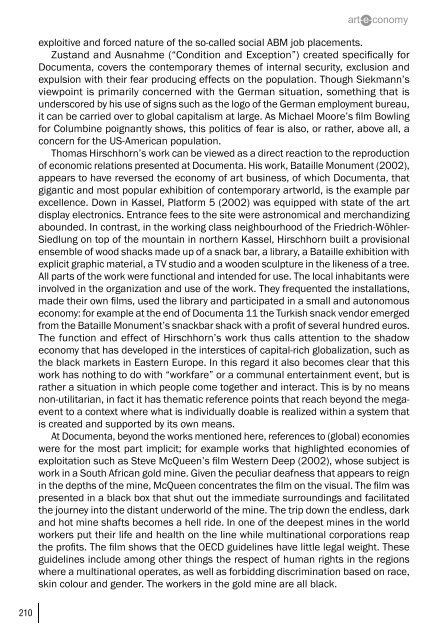art-e-conomy _ reader - marko stamenkovic
art-e-conomy _ reader - marko stamenkovic
art-e-conomy _ reader - marko stamenkovic
Create successful ePaper yourself
Turn your PDF publications into a flip-book with our unique Google optimized e-Paper software.
210<br />
exploitive and forced nature of the so-called social ABM job placements.<br />
Zustand and Ausnahme (“Condition and Exception”) created specifically for<br />
Documenta, covers the contemporary themes of internal security, exclusion and<br />
expulsion with their fear producing effects on the population. Though Siekmann’s<br />
viewpoint is primarily concerned with the German situation, something that is<br />
underscored by his use of signs such as the logo of the German employment bureau,<br />
it can be carried over to global capitalism at large. As Michael Moore’s film Bowling<br />
for Columbine poignantly shows, this politics of fear is also, or rather, above all, a<br />
concern for the US-American population.<br />
Thomas Hirschhorn’s work can be viewed as a direct reaction to the reproduction<br />
of economic relations presented at Documenta. His work, Bataille Monument (2002),<br />
appears to have reversed the e<strong>conomy</strong> of <strong>art</strong> business, of which Documenta, that<br />
gigantic and most popular exhibition of contemporary <strong>art</strong>world, is the example par<br />
excellence. Down in Kassel, Platform 5 (2002) was equipped with state of the <strong>art</strong><br />
display electronics. Entrance fees to the site were astronomical and merchandizing<br />
abounded. In contrast, in the working class neighbourhood of the Friedrich-Wöhler-<br />
Siedlung on top of the mountain in northern Kassel, Hirschhorn built a provisional<br />
ensemble of wood shacks made up of a snack bar, a library, a Bataille exhibition with<br />
explicit graphic material, a TV studio and a wooden sculpture in the likeness of a tree.<br />
All p<strong>art</strong>s of the work were functional and intended for use. The local inhabitants were<br />
involved in the organization and use of the work. They frequented the installations,<br />
made their own films, used the library and p<strong>art</strong>icipated in a small and autonomous<br />
e<strong>conomy</strong>: for example at the end of Documenta 11 the Turkish snack vendor emerged<br />
from the Bataille Monument’s snackbar shack with a profit of several hundred euros.<br />
The function and effect of Hirschhorn’s work thus calls attention to the shadow<br />
e<strong>conomy</strong> that has developed in the interstices of capital-rich globalization, such as<br />
the black markets in Eastern Europe. In this regard it also becomes clear that this<br />
work has nothing to do with “workfare” or a communal entertainment event, but is<br />
rather a situation in which people come together and interact. This is by no means<br />
non-utilitarian, in fact it has thematic reference points that reach beyond the megaevent<br />
to a context where what is individually doable is realized within a system that<br />
is created and supported by its own means.<br />
At Documenta, beyond the works mentioned here, references to (global) economies<br />
were for the most p<strong>art</strong> implicit; for example works that highlighted economies of<br />
exploitation such as Steve McQueen’s film Western Deep (2002), whose subject is<br />
work in a South African gold mine. Given the peculiar deafness that appears to reign<br />
in the depths of the mine, McQueen concentrates the film on the visual. The film was<br />
presented in a black box that shut out the immediate surroundings and facilitated<br />
the journey into the distant underworld of the mine. The trip down the endless, dark<br />
and hot mine shafts becomes a hell ride. In one of the deepest mines in the world<br />
workers put their life and health on the line while multinational corporations reap<br />
the profits. The film shows that the OECD guidelines have little legal weight. These<br />
guidelines include among other things the respect of human rights in the regions<br />
where a multinational operates, as well as forbidding discrimination based on race,<br />
skin colour and gender. The workers in the gold mine are all black.


